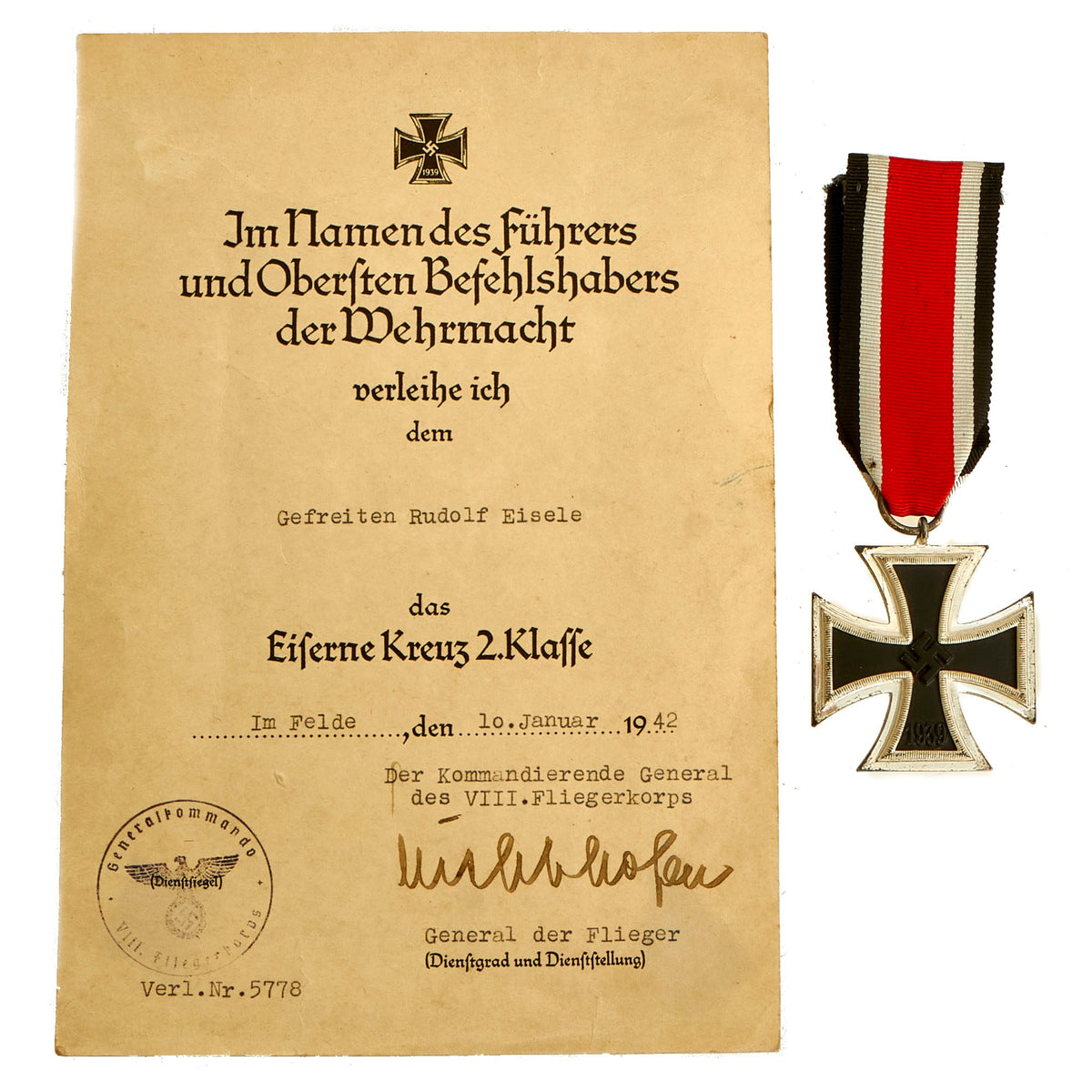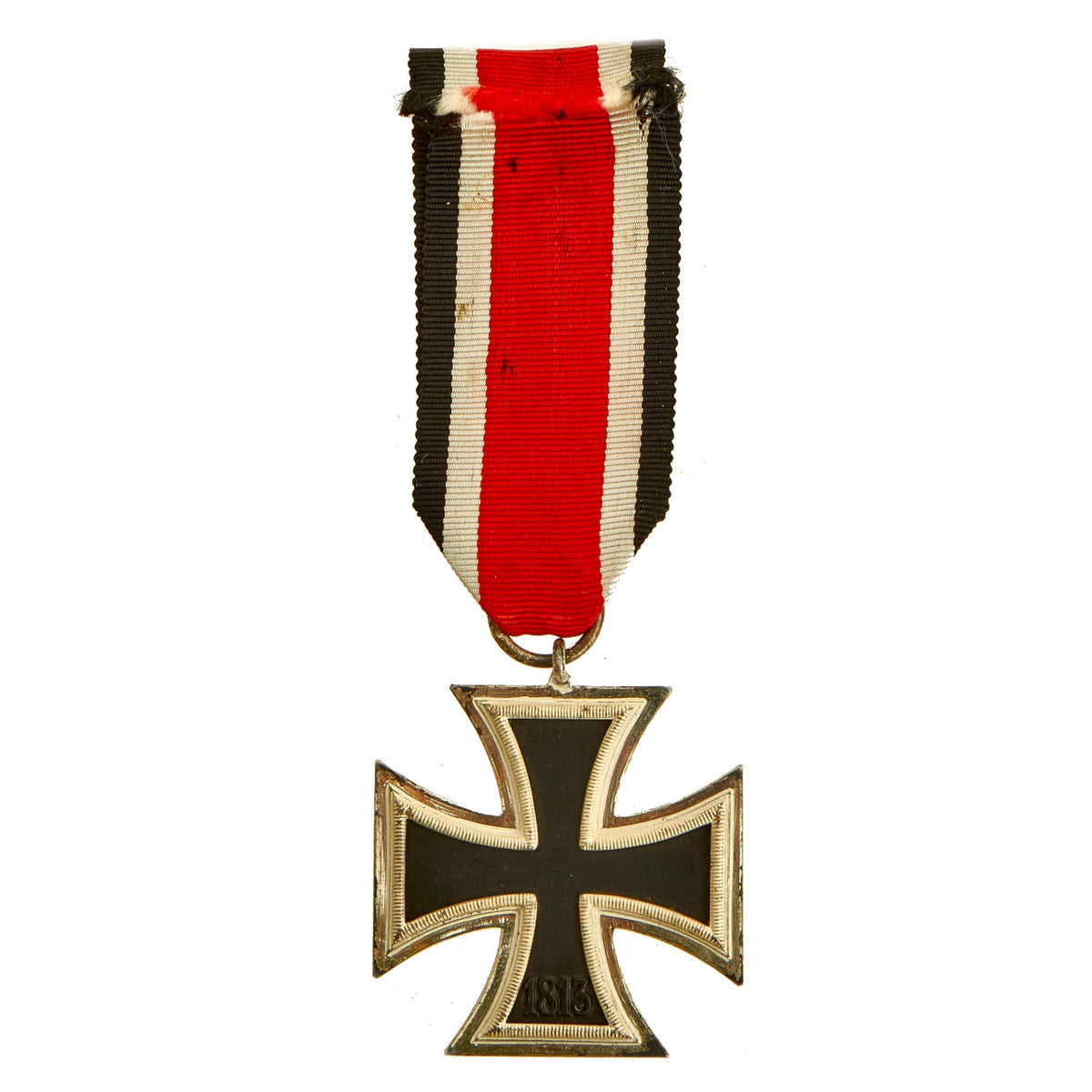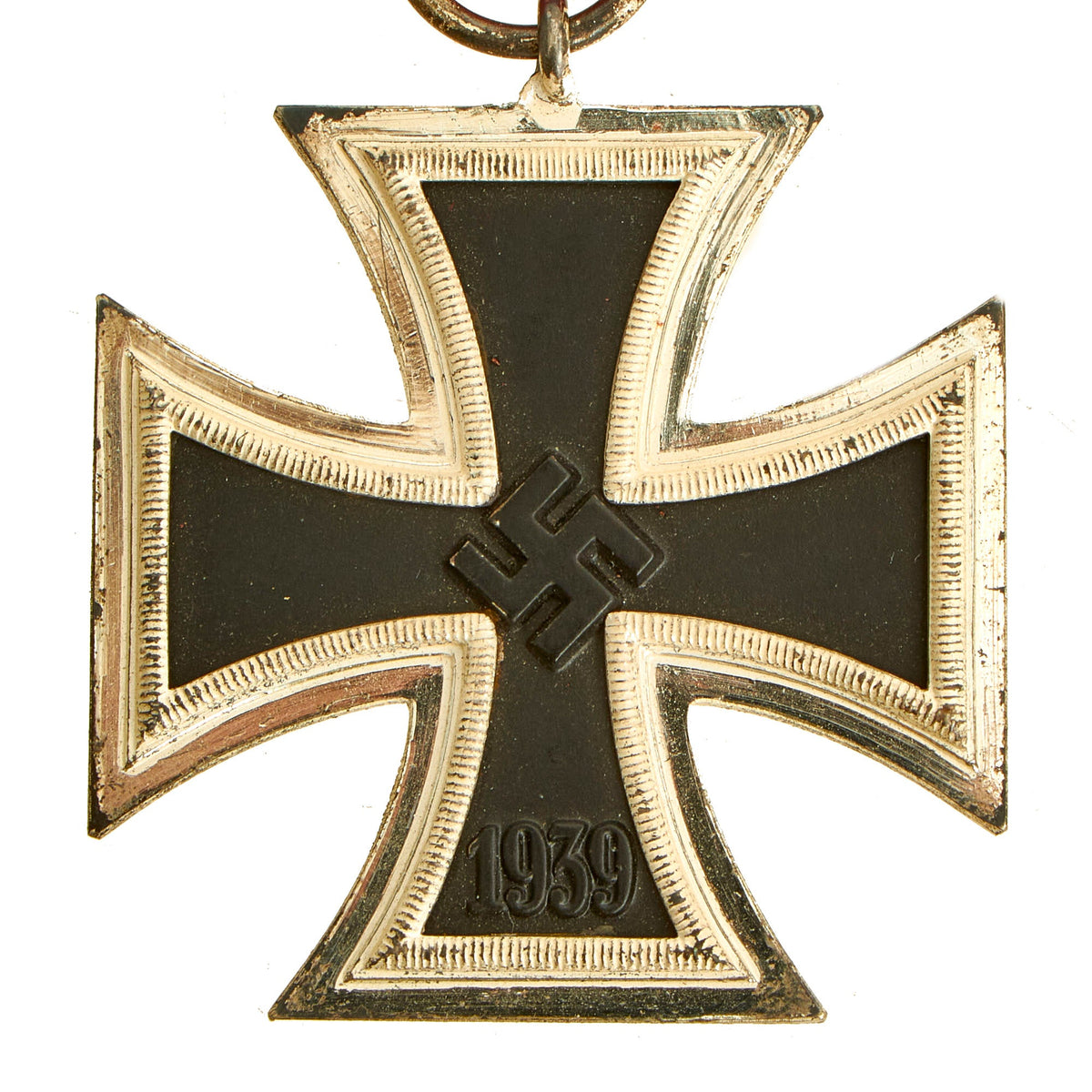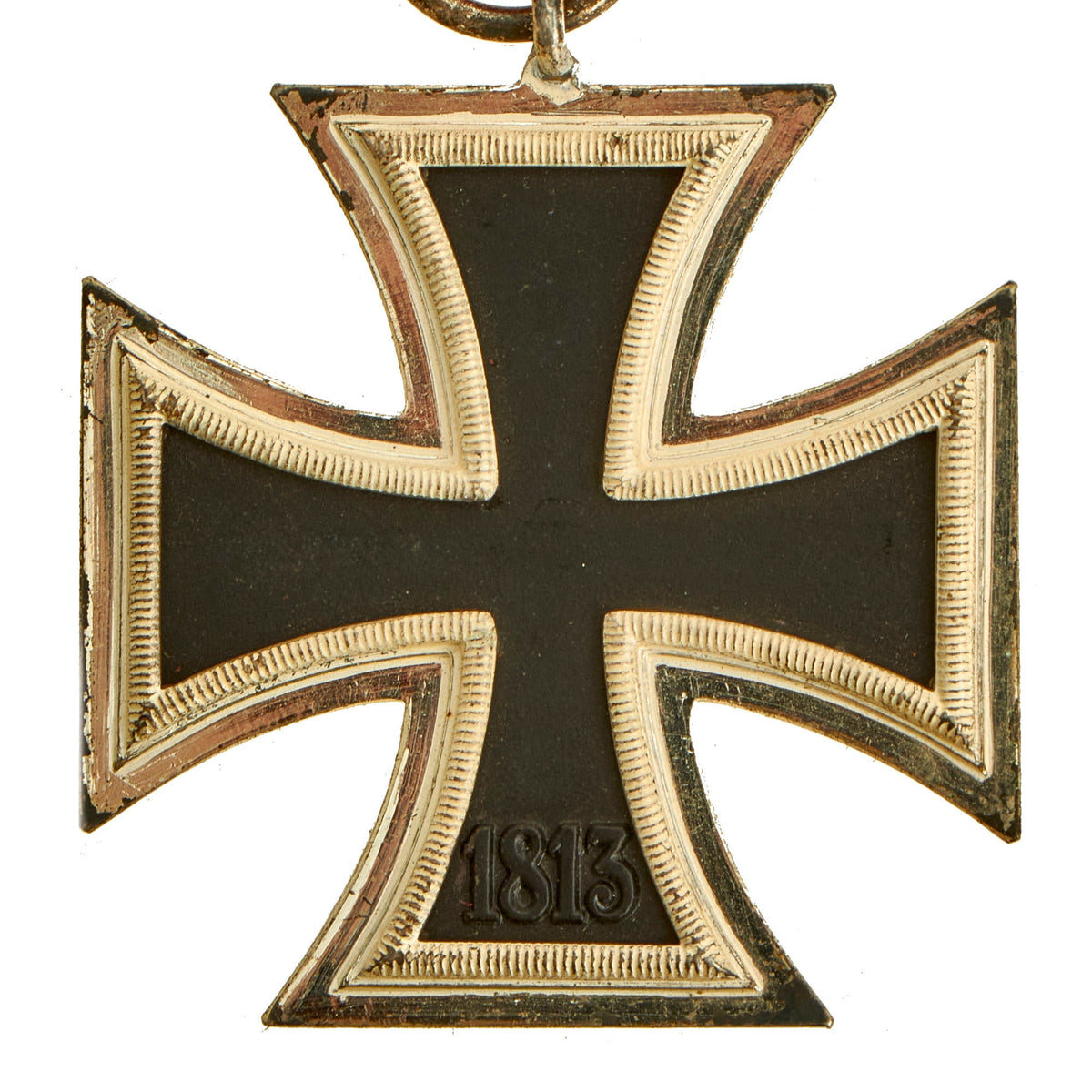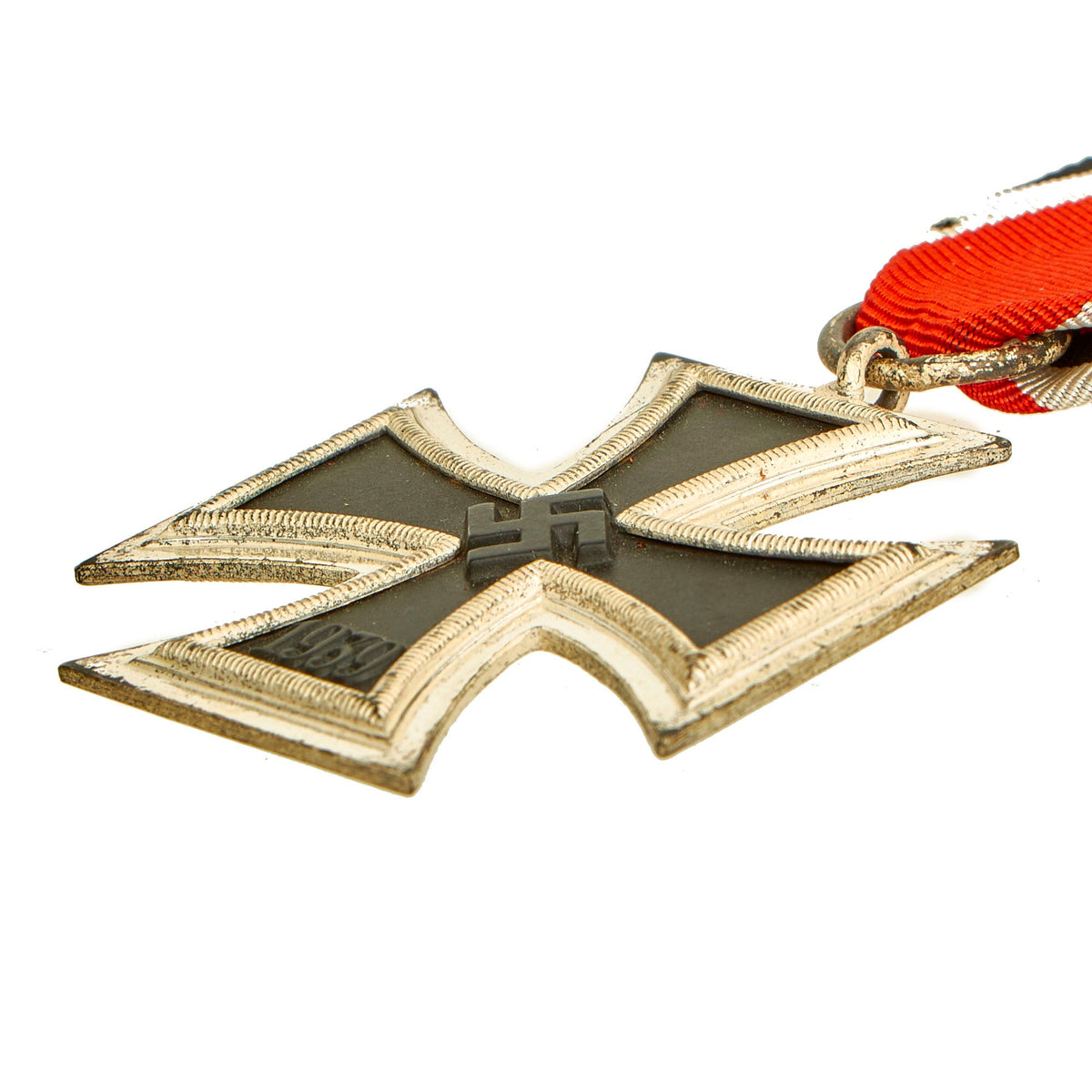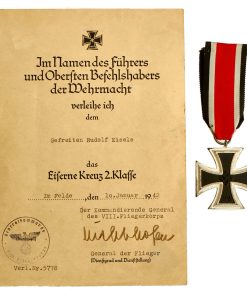Original German WWII Iron Cross 2nd Class 1939 with Named Award Document & Ribbon – EKII Original Items
$ 325,00 $ 97,50
Original Item: Only One Available. This is a great example of a German WWII Iron Cross 2nd Class 1939 (Eisernes Kreuz II. Klasse 1939) with its original rayon red, black, and white ribbon. Also included is the original besittzzeugnis “possession/award” certificate!
The award document indicates that it was awarded to Gefreiten Rudolf Eisele, an Enlisted man in Luftwaffe with a rank equivalent to a U.S. Army Air Forces Airman. It was awarded Im Felde (in the field) on 10 Januar 1942. It has the stamp of the Generalkommando VIII. Fliegerkorps (General Command 8th Air corps) in the lower left, and is signed by Der Kommandierende General des VIII. Fliegerkorps (The Commanding General of VIII Air Corps), signed Richthofen / General der Flieger. Research indicates this was General der Flieger, Generaloberst, and later Generalfeldmarschall Wolfram von Richthofen. A noted commander during WWII, he was also the cousin of WWI flying aces Lothar and Manfred von Richthofen, the latter of which is better known as the “Ace of Aces” of WWI, The Red Baron. Manfred encouraged Wolfram to join the Imperial Air Service, and he was assigned to Manfred’s Jagdgeschwader 1 “Flying Circus”. Unfortunately Wolfram’s first mission with the unit on 21 April 1918 was to be Manfred’s last, as he was shot down, ending his reign in the skies. Wolfram went on to claim 8 victories before the end of the war, which technically made him an “Ace” as well. Definitely some good research potential here!
The document has all the correct stamps and markings, and measures about 7 7/8″ x 5 1/2″, ( about 20cm x 14cm), printed on heavy-weight paper with black print and typed in particulars. It is in good condition, and has not been folded in half. There are some pieces of tape on the back where it was previously attached to a red backing.
The Iron Cross itself is a very fine example with crisp beading, and like most we see is not maker marked. The silvering to the frame is still mostly bright and looks great! The core paint on the iron center is also almost fully complete on both sides, with no wear on the Swas (hook cross) or other raised portions. There is a bit of light crazing in the finish, which confirms the age. The cross comes with its original ribbon, properly installed on the award, which shows some light staining from handing and possibly use.
Please also note the edge seam for authentication, which is not present on reproductions. Iron crosses were commonly constructed from an iron core sandwiched in a surrounding two part silver frame, normally the seam of these two silver parts is visible around the edge of the cross as is seen on this fine example.
The basic design of the WWII crosses is a central Tatzenkreuz (cross pattée) struck from iron and mounted in a silver frame which has a raised crenulated decorative border. The obverse of the cross bears the date 1939 under a “mobile” swas. Second class crosses would have a ring at the top where a ring was attached, and had more markings on the back. The first class award, however, was meant to attach directly to the front of the uniform.
A great example of the most iconic of all German awards, complete with an original award document and ribbon, ready to research and display!
There is no more iconic German military award than the Iron Cross. The long history of this order began during the Napoleonic Wars. King Friedrich Wilhelm III of Prussia instituted the “Eisernes Kreuz” (Iron Cross) in March of 1813. The award criteria changed somewhat with time, but generally speaking, Iron Crosses could be awarded for individual acts of bravery, or for leadership achievements on the battlefield. The design was created by a Karl Friedrich Schinkel, his choice of the black cross with silver outline was derived from the heraldic emblem of the Teutonic Knights.
There were a number of different type and grades of Iron Cross awards throughout its long history, but the basic details of the most widely awarded grades: The Iron Cross 1st Class and Iron Cross 2nd Class- remained the same. The first class award was a breast badge, with fittings on the reverse to allow it to be worn on the uniform. These fittings varied widely over time and from maker to maker, and could be a simple in and catch, a screw post and retaining disc, or more elaborate setups. The second class award was suspended from a ribbon, originally in the Prussian colors of black and white, later in the Reich colors of black, red and white.
On the original versions of these crosses, in 1813, the front of the iron core of each grade was bare, and only the second class award had ornamentation: a crown over the initials “FW” representing the King, a sprig of oak leaves, and the date 1813. The core was redesigned in 1870, when the cross was re-instituted during the Franco-Prussian War. The reverse ornamentation on the Iron Cross 2nd Class remained the same, but the front of the core on both grades now bore another crown, a “W” representing Kaiser Wilhelm, and the date 1870. This pattern repeated again when the cross was reinstituted for WWI- everything stayed the same, only the date 1870 was replaced with 1914.
The final reinstitution of the cross came in 1939. For this version, the front of the core for both grades bore a swas and the date 1939. The oak leaves, crown and royal initials were removed from the reverse, with only the date 1813 remaining as a reminder of the legacy of this award. In WWII, hundreds of thousands of Iron Cross First Class awards were bestowed, and four and a half million Iron Cross Second Class awards. Iron Crosses were made by a large number of authorized manufacturers. Some variants of these awards were mass produced in huge numbers. Others were made in very limited quantities.
The Iron Cross was normally a military decoration only, though there were instances of it being awarded to civilians for performing military functions. Two examples of this were civilian test pilots Hanna Reitsch who was awarded the Iron Cross 2nd Class and 1st Class and Melitta Schenk Gräfin von Stauffenberg, who was awarded the Iron Cross 2nd Class, for their actions as pilots during World War II.
Fast Shipping with Professional Packaging
Thanks to our longstanding association with UPS FedEx DHL, and other major international carriers, we are able to provide a range of shipping options. Our warehouse staff is expertly trained and will wrap your products according to our exact and precise specifications. Prior to shipping, your goods will be thoroughly examined and securely secured. We ship to thousands clients each day across multiple countries. This shows how we're dedicated to be the largest retailer on the internet. Warehouses and distribution centres can be located throughout Europe as well as the USA.
Note: Orders with more than one item will be assigned a processing date depending on the item.
Before shipping before shipping, we'll conduct a thorough inspection of the items you have ordered. Today, the majority of orders will be delivered within 48 hours. The delivery time will be between 3-7 days.
Returns
The stock is dynamic and we cannot completely manage it because multiple stakeholders are involved, including our factory and warehouse. So the actual stock may alter at any time. It's possible that you may not receive your order once the order has been made.
Our policy is valid for a period of 30 days. If you don't receive the product within 30 days, we are not able to issue a refund or an exchange.
You can only return an item if it is unused and in the same state as the day you received it. You must have the item in its original packaging.
Related products
Uncategorized
Angolan Rebel 1970s era 60mm Inert Display Mortar from Angolan Civil War Original Items
Uncategorized
Uncategorized
Uncategorized
Uncategorized
Uncategorized
Uncategorized
Uncategorized
Uncategorized
Uncategorized
Uncategorized
Uncategorized
Uncategorized
Uncategorized
Uncategorized
Uncategorized
